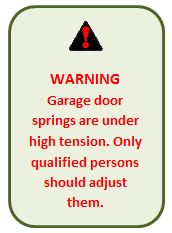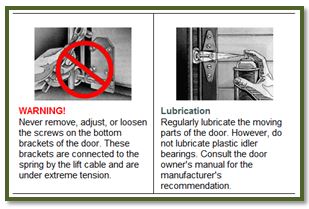Garage Door Care and Maintenance
Garage doors require care and maintenance to perform in the safest and most effective manner. Inspecting and testing your garage door system takes only a few minutes and should be performed monthly. Just make garage door care and maintenance part of your chore routine!
So, how hard can it be? Luckily, it’s not too complicated!
Before we get started, it’s important to issue a warning. At the risk of stating the obvious, please keep in mind that your garage door is typically the largest moving object in your home and many of its parts are under very high tension. The purpose of inspecting and testing your garage door system is to alert you to any potential issues.
The installation and maintenance of your garage door systems should be conducted by a trained, garage door systems professional. The improper installation or maintenance of a garage door can create hazardous conditions that can cause serious injury or even death. If you believe that your garage door, electric opener or related hardware needs repair, call a trained garage door systems service technician.
Here’s a summary of some of the most important parts of a basic inspection of your residential garage door that is connected to an electric garage door opener.
Manual Release Handle
Check to see if there is a red manual release handle hanging from your garage door opener. It should be easily accessible and hang no more than six feet above your garage floor. This is important so that you can disengage the garage opener if you need to open or close your garage door manually.
Door Panels
It’s important to check the condition of your panels. To do this you must first make sure the garage door is fully closed. Then, from inside your garage, check for any signs of cracking, buckling, separation of materials or general fatigue of your panels. If you see any of these signs, your garage door could present a hazardous condition to you and the contents of your garage. At this point, stop your inspection and call a trained garage door technician to finish inspecting your garage door and related hardware.
Warning Labels
While looking for warning labels on your garage door system may seem like a least important task during your inspection, the presence of these labels will inform you of the most dangerous parts of your garage door. They should be present at all times. You can check for these labels while standing inside your garage with the door closed. Your door system should have a warning label attached:
- On or next to the garage door spring assembly
- The back of one of the door panels
- The wall in the area of your wall control button
- Two warning labels attached to the garage door in the area of the bottom corner brackets. Some newer doors do not require these two labels, so don’t be alarmed if they are not there – they are tamper resistant!
Spring and Hardware Inspection
Check to see if all of your hardware is securely attached. It’s also very important to visually inspect your springs for damage. You can do this from inside your garage when the garage door is in the closed position.
Before you do this, here is an extreme warning:
According to DASMA (Door & Access Systems Manufacturers Association International), “Garage door springs, cables, brackets, and other hardware attached to the springs are under very high tension and, if handled improperly, can cause serious injury. Only a qualified professional should adjust them. The torsion springs (the springs above the door) should only be adjusted by a professional. Do not attempt to repair or adjust torsion springs yourself. A restraining cable or other device should be installed on the extension spring (the spring along the side of the door) to help contain the spring if it breaks.”
Door Operation
Make sure there are handles or grip points on both the inside and outside of your garage door. From inside the garage with your garage door closed, pull the manual release to disconnect your door from the opener. Without straining yourself, manually lift and the garage door by grasping the door in an area that your fingers cannot be injured. If the door is too hard to lift, then this is usually an indication that your door is out of balance or there are other issues and that maintenance is required. The idea is that your garage door should move freely and be raised to the fully open position without difficulty. It should also be closed without difficulty. At this point, you can visually see if the roller is staying within their track. If any rollers fall out of the track, the door system should be repaired by a trained door systems technician. If there are no issues after conducting this check, reconnect the door to the opener.
Wall Station Push-Button
Your garage door should have at least on working wall-mounted push-button to operate your garage door opener. Your push-button should stand at least five feet above your garage floor and be high enough out of the reach of small children. Press the push-button to make sure it successfully operates the garage door.
Photo Eyes and Non-Contact Door Reversal Test
Federal laws states that residential garage door openers made after 1992 must be equipped with photo eyes that meet UL 325 standards. Photo eyes should be mounted to the left and right sides at the bottom of the door opening. They should be no more than six inches above the garage door floor. Photo eyes are a safety-reverse feature that causes the garage door to stop closing if any object has been detected within the photo-eye beam. Make sure your photo eyes are clear of any debris including cobwebs and dust and are clean so they can operate properly.
To check that your photo eyes are operating correctly, do the following: Stand inside the garage (but safely away from the path of the door), push your remote control or wall button close the garage door. As your garage door is closing, wave an object in the path of the photoelectric eye beam. Make sure the object you are waving is not something of value to you and at substantial distance from the garage door. If the garage door reverses, then your photo eyes are working correctly. If not, the garage door will close on your object. You will need to open the door to release the object used.
For fast, professional, dependable garage door care and maintenance call River City Door at 513-662-3667 or 812-637-6500 or contact us online. River City Door proudly serves Greater Cincinnati, Southeast Indiana and Northern Kentucky communities.



